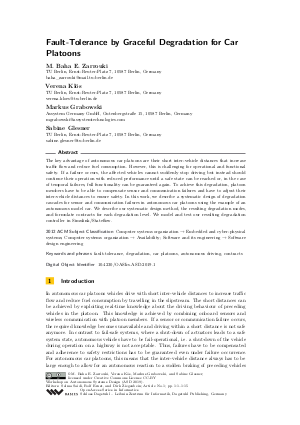Fault-Tolerance by Graceful Degradation for Car Platoons
Authors M. Baha E. Zarrouki, Verena Klös, Markus Grabowski, Sabine Glesner
-
Part of:
Volume:
Workshop on Autonomous Systems Design (ASD 2019)
Part of: Series: Open Access Series in Informatics (OASIcs)
Part of: Conference: Workshop on Autonomous Systems Design (ASD) - License:
 Creative Commons Attribution 3.0 Unported license
Creative Commons Attribution 3.0 Unported license
- Publication Date: 2019-03-28
File

PDF
OASIcs.ASD.2019.1.pdf
- Filesize: 0.93 MB
- 15 pages
Document Identifiers
Subject Classification
ACM Subject Classification
- Computer systems organization → Embedded and cyber-physical systems
- Computer systems organization → Availability
- Software and its engineering → Software design engineering
Keywords
- fault-tolerance
- degradation
- car platoons
- autonomous driving
- contracts
Metrics
- Access Statistics
-
Total Accesses (updated on a weekly basis)
0PDF Downloads0Metadata Views
Abstract
The key advantage of autonomous car platoons are their short inter-vehicle distances that increase traffic flow and reduce fuel consumption. However, this is challenging for operational and functional safety. If a failure occurs, the affected vehicles cannot suddenly stop driving but instead should continue their operation with reduced performance until a safe state can be reached or, in the case of temporal failures, full functionality can be guaranteed again. To achieve this degradation, platoon members have to be able to compensate sensor and communication failures and have to adjust their inter-vehicle distances to ensure safety. In this work, we describe a systematic design of degradation cascades for sensor and communication failures in autonomous car platoons using the example of an autonomous model car. We describe our systematic design method, the resulting degradation modes, and formulate contracts for each degradation level. We model and test our resulting degradation controller in Simulink/Stateflow.
Cite As Get BibTex
M. Baha E. Zarrouki, Verena Klös, Markus Grabowski, and Sabine Glesner. Fault-Tolerance by Graceful Degradation for Car Platoons. In Workshop on Autonomous Systems Design (ASD 2019). Open Access Series in Informatics (OASIcs), Volume 68, pp. 1:1-1:15, Schloss Dagstuhl – Leibniz-Zentrum für Informatik (2019)
https://doi.org/10.4230/OASIcs.ASD.2019.1
BibTex
@InProceedings{zarrouki_et_al:OASIcs.ASD.2019.1,
author = {Zarrouki, M. Baha E. and Kl\"{o}s, Verena and Grabowski, Markus and Glesner, Sabine},
title = {{Fault-Tolerance by Graceful Degradation for Car Platoons}},
booktitle = {Workshop on Autonomous Systems Design (ASD 2019)},
pages = {1:1--1:15},
series = {Open Access Series in Informatics (OASIcs)},
ISBN = {978-3-95977-102-3},
ISSN = {2190-6807},
year = {2019},
volume = {68},
editor = {Saidi, Selma and Ernst, Rolf and Ziegenbein, Dirk},
publisher = {Schloss Dagstuhl -- Leibniz-Zentrum f{\"u}r Informatik},
address = {Dagstuhl, Germany},
URL = {https://drops.dagstuhl.de/entities/document/10.4230/OASIcs.ASD.2019.1},
URN = {urn:nbn:de:0030-drops-103344},
doi = {10.4230/OASIcs.ASD.2019.1},
annote = {Keywords: fault-tolerance, degradation, car platoons, autonomous driving, contracts}
}
Author Details
References
-
Jairo Giraldo, David Urbina, Alvaro Cardenas, Junia Valente, Mustafa Faisal, Justin Ruths, Nils Ole Tippenhauer, Henrik Sandberg, and Richard Candell. A Survey of Physics-Based Attack Detection in Cyber-Physical Systems. ACM Computing Surveys (CSUR), 51(4):76, 2018.

-
Markus Grabowski, Bernhard Kaiser, and Yu Bai. Systematic Refinement of CPS Requirements using SysML, Template Language and Contracts. In Ina Schaefer, Dimitris Karagiannis, Andreas Vogelsang, Daniel Méndez, and Christoph Seidl, editors, Modellierung 2018, pages 245-260, Bonn, 2018. Gesellschaft für Informatik e.V.

-
ISO. ISO 26262 Road vehicles - Functional safety. Standard, International Organization for Standardization, 2011. In several parts: 1: Vocabulary, 2: Management of functional safety, 3: Concept phase, 4: Product development at the system level, 5: Product development at the hardware level, 6: Product development at the software level, 7: Production and operation, 8: Supporting processes, 9: Automotive Safety Integrity Level (ASIL)-oriented and safety-oriented analyses, 10: Guideline on ISO 26262.

-
B Kaiser, B Monajemi Nejad, D Kusche, and H Schulte. Systematic design and validation of degradation cascades for safety-relevant systems. In Annual European Safety and Reliability Conference ESREL, 2017.

-
Bernhard Kaiser, Raphael Weber, Markus Oertel, Eckard Böde, Behrang Monajemi Nejad, and Justyna Zander. Contract-based design of embedded systems integrating nominal behavior and safety. Complex Systems Informatics and Modeling Quarterly, 4:66-91, 2015.

-
Jeroen Ploeg, Elham Semsar-Kazerooni, Guido Lijster, Nathan van de Wouw, and Henk Nijmeijer. Graceful degradation of CACC performance subject to unreliable wireless communication. In 16th International IEEE Conference on Intelligent Transportation Systems (ITSC), pages 1210-1216. IEEE, 2013.

-
Rajesh Rajamani, Adam S Howell, Chieh Chen, J Karl Hedrick, and Masayoshi Tomizuka. A complete fault diagnostic system for automated vehicles operating in a platoon. IEEE Transactions on Control Systems Technology, 9(4):553-564, 2001.

- SAE International. Taxonomy and Definitions for Terms Related to On-Road Motor Vehicle Automated Driving Systems, January 2014. URL: http://dx.doi.org/10.4271/J3016_201401.
-
Irfan Sljivo, Barbara Gallina, and Bernhard Kaiser. Assuring degradation cascades of car platoons via contracts. In International Conference on Computer Safety, Reliability, and Security, pages 317-329. Springer, 2017.

